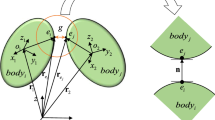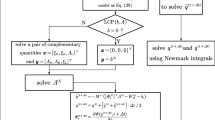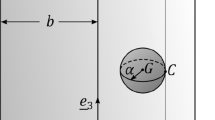Abstract
A large number of collisions and frictions often occur in multibody systems. These nonsmooth events lead to discontinuous or piecewise-continuous dynamic equations of multibody systems, which brings great difficulties to the numerical solution. Accordingly, it is very difficult to calculate the dynamic sensitivity of nonsmooth multibody systems. In this paper, the analytical sensitivity formula of nonsmooth multibody systems with contact and friction is derived by the direct differentiation method. Also, a complete and unified mathematical framework for dynamic sensitivity analysis of nonsmooth multibody systems is given. On this basis, combined with the advantages of the finite-difference method, a semianalytical sensitivity-analysis method for nonsmooth multibody systems is further derived. For the dynamic equations in the form of differential–algebraic equations, the formulas of analytical and semianalytical sensitivity-analysis methods are given, including a global semianalytical method and a local semianalytical method. The correctness is verified by three numerical examples of nonsmooth multibody systems, and the results show that the semianalytical sensitivity-analysis method is effective and practical in engineering application.



















Similar content being viewed by others
References
Benvenuto, R., Lavagna, M., Salvi, S.: Multibody dynamics driving GNC and system design in tethered nets for active debris removal. Adv. Space Res. 58(1), 45–63 (2016)
Sun, J.L., Tian, Q., Hu, H.Y., Pedersen, N.L.: Topology optimization of a flexible multibody system with variable-length bodies described by ALE-ANCF. Nonlinear Dyn. 93(2), 413–441 (2018)
Peng, H.J., Li, F., Liu, J.G., Ju, Z.J.: A symplectic instantaneous optimal control for robot trajectory tracking with differential-algebraic equation models. IEEE Trans. Ind. Electron. 67(5), 3819–3829 (2020)
Callejo, A., Dopico, D.: Direct sensitivity analysis of multibody systems: a vehicle dynamics benchmark. J. Comput. Nonlinear Dyn. 14(2), 1–9 (2019)
Pfeiffer, F., Glocker, C.: Contacts in multibody systems. J. Appl. Math. Mech. 64(5), 773–782 (2000)
Yu, X.X., Matikainen, M.K., Harish, A.B., Mikkola, A.: Procedure for non-smooth contact for planar flexible beams with cone complementarity problem. Proc. Inst. Mech. Eng., Part K, J. Multi-Body Dyn. 235(2), 179–196 (2021)
Botta, E.M., Sharf, I., Misra, A.K.: Contact dynamics modeling and simulation of tether nets for space-debris capture. J. Guid. Control Dyn. 40(1), 110–123 (2017)
Skrinjar, L., Slavic, J., Boltezar, M.: A review of continuous contact-force models in multibody dynamics. Int. J. Mech. Sci. 145, 171–187 (2018)
Machado, M., Moreira, P., Flores, P., Lankarani, H.M.: Compliant contact force models in multibody dynamics: evolution of the Hertz contact theory. Mech. Mach. Theory 53, 99–121 (2012)
Moreau, J.: Unilateral Problems in Structural Analysis, pp. 173–221. Springer, Vienna (1985)
Gao, H.P., Wang, Q., Wang, S.M., Fu, L.: A linear complementarity model for multibody systems with frictional unilateral and bilateral constraints. Acta Mech. Sin. 27(4), 587–592 (2011)
Zhuang, F.F., Wang, Q.: Modeling and analysis of rigid multibody systems with driving constraints and frictional translation joints. Acta Mech. Sin. 30(3), 437–446 (2014)
Anitescu, M., Hart, G.D.: A constraint-stabilized time-stepping approach for rigid multibody dynamics with joints, contact and friction. Int. J. Numer. Methods Eng. 60(14), 2335–2371 (2004)
Fu, L., Wang, Q., Wang, S.M.: Time-stepping for multibody dynamics with friction-affected bilateral constraints. Prog. Nat. Sci. 19(12), 1799–1804 (2009)
Peng, H.J., Song, N.N., Kan, Z.Y.: A novel nonsmooth dynamics method for multibody systems with friction and impact based on the symplectic discrete format. Int. J. Numer. Methods Eng. 121(7), 1530–1557 (2020)
Song, N.N., Peng, H.J., Kan, Z.Y., Chen, B.S.: A novel nonsmooth approach for flexible multibody systems with contact and friction in 3D space. Nonlinear Dyn. 102, 1375–1408 (2020)
Kanzow, C.: Some noninterior continuation methods for linear complementarity problems. SIAM J. Matrix Anal. Appl. 17(4), 851–868 (1996)
Tromme, E., Bruls, O., Duysinx, P.: Weakly and fully coupled methods for structural optimization of flexible mechanisms. Multibody Syst. Dyn. 38(4), 391–417 (2015)
Zhang, M.R., Peng, H.J., Song, N.N.: Semi-analytical sensitivity analysis approach for fully coupled optimization of flexible multibody systems. Mech. Mach. Theory 159, 104256 (2021)
Ding, J.Y., Pan, Z.K., Chen, L.Q.: Second-order sensitivity analysis of multibody systems described by differential/algebraic equations: adjoint variable approach. Int. J. Comput. Math. 85(6), 899–913 (2008)
Ding, J.Y., Pan, Z.K., Chen, L.Q.: Parameter identification of multibody systems based on second order sensitivity analysis. Int. J. Non-Linear Mech. 47(10), 1105–1110 (2012)
Peng, H.J., Zhang, M.R., Zhang, L.D.: Semi-analytical sensitivity analysis for multibody system dynamics described by differential-algebraic equations. AIAA J. 59(3), 893–904 (2021)
Greene, W.H., Haftka, R.T.: Computational aspects of sensitivity calculations in linear transient structural analysis. Struct. Optim. 3(3), 176–201 (1991)
Etman, L.F.P., van Campen, D.H., Schoofs, A.J.G.: Design optimization of multibody systems by sequential approximation. Multibody Syst. Dyn. 2(4), 393–415 (1998)
Haug, E.J., Mani, N.K., Krishnasawami, P.: Computer Aided Analysis and Optimization of Mechanical System Dynamics, pp. 555–636. Springer, Berlin (1984)
Haug, E.J., Arora, J.S.: Design sensitivity analysis of elastic mechanical systems. Comput. Methods Appl. Mech. Eng. 15(1), 35–62 (1978)
Dopico, D., González, F., Luaces, A., Saura, M., García-Vallejo, D.: Direct sensitivity analysis of multibody systems with holonomic and nonholonomic constraints via an index-3 augmented Lagrangian formulation with projections. Nonlinear Dyn. 93(4), 2039–2056 (2018)
Pi, T., Zhang, Y.Q., Chen, L.P.: First order sensitivity analysis of flexible multibody systems using absolute nodal coordinate formulation. Multibody Syst. Dyn. 27(2), 153–171 (2011)
Nachbagauer, K., Oberpeilsteiner, S., Sherif, K., Steiner, W.: The use of the adjoint method for solving typical optimization problems in multibody dynamics. J. Comput. Nonlinear Dyn. 10(6), 061011 (2015)
Sonneville, V., Bruls, O.: Sensitivity analysis for multibody systems formulated on a Lie group. Multibody Syst. Dyn. 31(1), 47–67 (2014)
Corner, S., Sandu, C., Sandu, A.: Modeling and sensitivity analysis methodology for hybrid dynamical system. Nonlinear Anal. Hybrid Syst. 31, 19–40 (2019)
Corner, S., Sandu, C., Sandu, A.: Adjoint sensitivity analysis of hybrid multibody dynamical systems. Multibody Syst. Dyn. 49(4), 395–420 (2020)
Ding, Z., Zhang, L., Gao, Q., Liao, W.H.: State-space based discretize-then-differentiate adjoint sensitivity method for transient responses of non-viscously damped systems. Comput. Struct. 250, 106540 (2021)
Anitescu, M., Potra, F.A., Stewart, D.E.: Time-stepping for three-dimensional rigid body dynamics. Comput. Methods Appl. Mech. Eng. 177(3–4), 183–197 (1999)
Acary, V.: Projected event-capturing time-stepping schemes for nonsmooth mechanical systems with unilateral contact and Coulomb’s friction. Comput. Methods Appl. Mech. Eng. 256, 224–250 (2013)
Cheng, G.D., Liu, Y.W.: A new computation scheme for sensitivity analysis. Eng. Optim. 12(3), 219–234 (1987)
Zhang, L.D., Chen, B.S.: Modified semi-analytical sensitivity analysis method and its application to stiffened structures. AIAA J. 56(9), 3791–3798 (2018)
Wang, Q.T., Tian, Q., Hu, H.Y.: Dynamic simulation of frictional contacts of thin beams during large overall motions via absolute nodal coordinate formulation. Nonlinear Dyn. 77(4), 1411–1425 (2014)
Kan, Z.Y., Peng, H.J., Chen, B.S., Zhong, W.X.: Nonlinear dynamic and deployment analysis of clustered tensegrity structures using a positional formulation FEM. Compos. Struct. 187, 241–258 (2018)
Murakami, H., Nishimura, Y.: Static and dynamic characterization of regular truncated icosahedral and dodecahedral tensegrity modules. Int. J. Solids Struct. 38(50–51), 9359–9381 (2001)
Kan, Z.Y., Li, F., Peng, H.J., Chen, B.S., Song, X.G.: Sliding cable modeling: a nonlinear complementarity function based framework. Mech. Syst. Signal Process. 146, 107021 (2021)
Acknowledgements
The authors are grateful for the financial support of the National Natural Science Foundation of China (grant numbers 11922203, 11772074).
Author information
Authors and Affiliations
Corresponding author
Ethics declarations
Conflict of Interest
The authors declare that they have no conflict of interest.
Additional information
Publisher’s Note
Springer Nature remains neutral with regard to jurisdictional claims in published maps and institutional affiliations.
Rights and permissions
About this article
Cite this article
Peng, H., Zhang, M., Song, N. et al. Sensitivity-analysis methods for nonsmooth multibody systems with contact and friction. Multibody Syst Dyn 54, 345–371 (2022). https://doi.org/10.1007/s11044-022-09810-7
Received:
Accepted:
Published:
Issue Date:
DOI: https://doi.org/10.1007/s11044-022-09810-7




